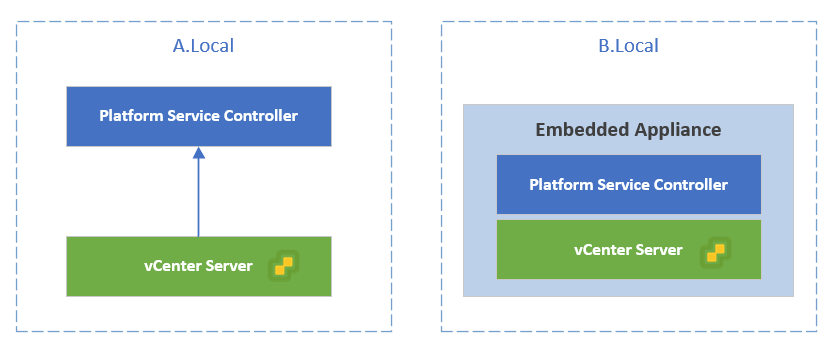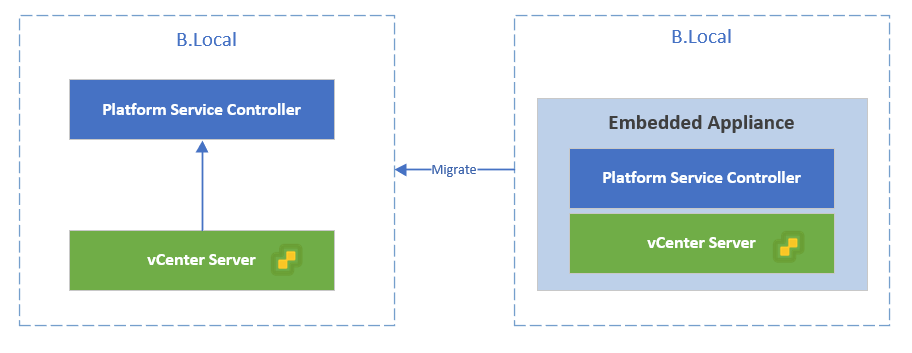With vSphere 6.7, VMWare has introduced fundamental changes on how you can deploy vCenter and platform service controller and create enhanced link mode. These are the new features introduced with vSphere 6.7:
- Cross domain repointing for vCenter servers.
- Create ELM using embedded vCenter deployment
- Requires no load balancer for high availability; fully supports native vCenter Server high availability.
- Provides flexibility of placement in the vSphere single sign-on (SSO) domain with site boundary removal.
- Allows up to 15 deployments of vCenters in a vSphere SSO domain.
Note: most of the new features like site removal or HA without the need of load balancer are exclusive to vCenters with embedded PSC deployment and mix of embedded and external configuration are not allowed in vSphere 6.7. Another important factor to consider is that vSphere 6.7 only supports ESXi version 6.0 and higher.
vCenter Embedded Linked Mode
The newest and most fundamental change that is introduced to vSphere 6.7 is the ability to deploy Embedded vCenter in Enhanced Linked Mode. Not only this deployment simplifies the node management but also removes the site boundaries and limitations which exist with external deployment type.

Other features of vCenter Embedded Linked Mode include:
- No external Platform Services Controller, providing a more simplified domain architecture than an external deployment with enhanced linked mode.
- A simplified backup and restore process. See “File-Based Backup and Restore of vCenter Server Appliance” for more information.
- A simplified HA process, removing the need for load balancers.
- Up to 15 vCenter Server Appliances can be linked together using vCenter Embedded Linked Mode and displayed in a single inventory view.
- For a vCenter High Availability (vCenter HA) cluster, three nodes are considered one logical vCenter Server node. See “vCenter Architecture Overview” in vSphere Availability for the vCenter HA architecture overview. A single vCenter Server standard license is needed for one vCenter HA cluster.
Note: cross domain is not supported for embedded deployment and if you want to consolidate the SSO domains, you need to first externalize your PSCs.{: .notice}
Enhanced Linked Mode in external PSC deployment
Nothing really has changed in vSphere 6.7 regarding ELM in external PSC deployment type. Following topologies are supported:
- Platform Services Controller with a Load Balancer.
- Platform Services Controller with Load Balancers Across vCenter Single Sign-On Sites.
- Platform Services Controller with No Load Balancer.
- Platform Services Controller with No Load Balancer Across vCenter Single Sign-On Sites.
Cross Domain Support in vSphere 6.7
Perhaps the most exciting new or, better say returning feature in vSphere 6.7 is the ability to consolidate or divide SSO domains. This functionality is not supported for embedded deployment, so if you want to consolidate two domains you first need to externalize your embedded deployment.
For example, let’s say we have and mix of external and embedded vCenters in two different domains and we would like to consolidate the domains into a single domain. Shown in Figure 2.

To consolidate the domains, first you need to externalize the embedded deployment and then repoint the vCenter to new SSO domain as shown in figure 3 and 4.

After externalizing the embedded appliance, then you can repoint the vCenter to a new domain and decommission the old domain.

I hope this post has been useful to you. For any question or suggestion please leave a comment below and I’ll be happy to get back to you.
Author: Arman Keyoumarsi